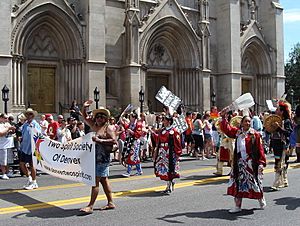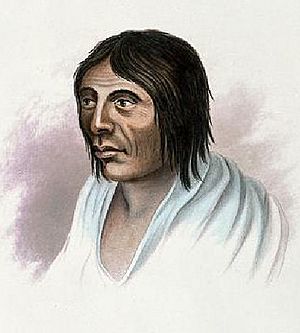Gender roles among the indigenous peoples of North America facts for kids
Native American and First Nations peoples have many different ways of life. Their traditional roles for men and women often varied a lot. These roles depended on the region and the specific community. What was traditional in the past might be different today. Many communities prefer not to share these details with outsiders.
Contents
Apache Ways of Life
Among the Apache people, both girls and boys learned many of the same skills. Traditionally, all children learned how to cook and follow tracks. They also learned to prepare animal hides and sew. Riding horses and using tools or weapons were also common skills.
Women usually gathered plants like fruits, roots, and seeds. They were also often in charge of preparing food. Men typically used tools and weapons to hunt animals such as buffalo. While women usually did not hunt, their role as mothers was very important. A special coming-of-age ceremony for young girls was a big event. During this ceremony, a girl would accept her role as a woman. She would also be blessed with a long life and many children. Apache families often lived in homes where a married couple stayed with the wife's family.
Eastern Woodland Communities
Eastern Woodland communities had different ways of dividing work between men and women. Generally, like in the Plains nations, women often owned the family home. Men's work might involve more travel.
For example, among the Narragansett in farming areas, men traditionally helped clear fields. They also helped grow and harvest crops. Women held important roles in the home. Among the Lenape, both men and women helped with farming and hunting. Their roles depended on their age and what they were good at. Women often led the farming efforts. Men usually had more responsibility for hunting. Older Lenape women were in charge of sharing food with the community. They also managed the land used for hunting or farming.
Historically, men and women in Eastern Woodland communities often had balanced power. Both men and women traditionally had the final say in who they would marry. However, parents usually had a lot of influence too.
Hopi Traditions
The Hopi people live in what is now northeastern Arizona. Traditionally, their society was organized through mothers' families. Women and men had equal roles in the community. There was no idea that one gender was better than the other. Both women and men traditionally took part in politics and community leadership.
However, when other cultures arrived, they brought new ideas. These ideas sometimes changed the traditional structures. They also affected the important roles women used to have. Even with these changes, the family lines are still traced through mothers. Mothers and grandmothers remain central to the family and clan structure.
Haudenosaunee Society
The Haudenosaunee society is organized through the mothers' families. Traditionally, the Clan Mother held great power over all decisions. Her specific role could be different in each Nation. In this system, the men under her were the Chiefs. They mainly worked as diplomats. Tradition says that the Clan Mother could stop any idea proposed by her chiefs. Also, family names and political power were passed down through the mother's side of the family.
Kalapuya Life and Roles
The Kalapuya people had a society where men often held leadership roles. Villages were usually led by a male leader or a group of leaders. The main leader was often the man with the most wealth. While some women were leaders, it was more common for women to gain status in spiritual leadership. Kalapuya groups usually included large families of related men, their wives, and children.
Spiritual leaders could be men or women. Spiritual power was seen as more important than material wealth. Because of this, spiritual leaders were often more influential than political leaders.
Kalapuya men usually hunted. Women and young children gathered food and set up camps. Most of the Kalapuya diet came from gathered food. This meant women provided most of the meals. Women were also in charge of preparing, preserving, and storing food. Men hunted animals like deer and elk. They also caught fish from the rivers of the Willamette Valley, such as salmon and eels. Plants gathered included wapato, tarweed seeds, hazelnuts, and especially camas. Women cooked the camas bulbs into a cake-like bread, which was very valuable.
Women were active in community life and shared their thoughts. When a man wanted to marry a woman, he would give a gift to her father.
After Europeans arrived in the Willamette Valley, changes occurred. The Grand Ronde Reservation and boarding schools like Chemawa Indian School taught Kalapuya children European ways of life.
Inuit Traditions
Arvilingjuarmiut People
The Arvilingjuarmiut, also known as Netsilik people, are Inuit. They mainly live in Kugaaruk and Gjoa Haven, Nunavut, Canada. They have a tradition called kipijuituq. This is when some children who are born male are raised as females. Often, grandparents decide if a baby will be Kipijuituq based on how the baby moves in the womb. These children would later choose their own gender when they became teenagers. This choice happened after a special coming-of-age event, which included hunting animals. A similar idea is sipiniq from the Igloolik and Nunavik areas.
Chugach Aranu’tiq
Aranu’tiq is a special category among the Chugach people of Alaska. It describes people who do not fit into only male or female roles. Children might dress in a mix of clothing for both boys and girls. Newborn babies are not seen as completely new people. Instead, they are called tarnina or inuusia, which means their soul or personality. They are named after an older family member who has passed away. This is a way of thinking about new life and connections.
The Navajo Nation society includes a special cultural role called nádleehi. This word means "one who is transformed" or "one who changes." This role is part of the "two-spirit" tradition in some Native American cultures. A famous example was the 19th-century Navajo artist Hosteen Klah (1849–1896).
Nez Perce Community Roles
During the early times of European arrival, Nez Perce communities had specific roles for men and women. Men were responsible for making tools for hunting and fishing. They also protected their communities. Men formed the governing groups of villages, which included a council and a headman.
Nez Perce women were in charge of keeping the household running. This included making useful tools for the home. Women also gathered medicinal plants because they had a lot of knowledge about them. Both women and children gathered edible plants. Women often took part in community discussions. However, because of their family duties and gathering medicine, they usually did not hold official leadership positions. Important knowledge about culture and traditions was passed down by all the older people in the community.
Ojibwe Traditions
Historically, most Ojibwe cultures believed that men and women were good at different tasks. Hunting was usually a man's job. Special feasts were held to honor successful hunters. Gathering wild plants was more often a woman's job. However, these tasks sometimes overlapped. Men and women might work on the same project but have different duties. For example, while men hunted, women helped by building shelters. They also prepared animal hides for clothing and dried meat. Today, all community members help with this work, no matter their gender.
Harvesting Wild rice (Ojibwe: manoomin) is a task for everyone in the community. Often, women would knock the rice grains into the canoe. Men would paddle and steer the canoe through the reeds. For Ojibwe women, the wild rice harvest was very important. It was a chance to show their independence.
The wild rice harvest showed how much freedom Ojibwe women had. Collecting rice was an important economic activity for women. They had rights to use wild rice beds in rivers and lakes. This was part of their traditions and laws. Ojibwe ideas about property were not like European laws. So, when early travelers saw Indigenous women working, it was a new idea for them. For the Ojibwe, water was a special place for women. Women's ceremonial duties for water came from these traditions and economic practices.
Today, both Ojibwe men and women take turns knocking rice grains while harvesting wild rice by canoe.
Both Ojibwe men and women create beadwork and music. They also keep the traditions of storytelling and traditional medicine alive. For clothing, Ojibwe women historically wore hide dresses with leggings and moccasins. Men wore leggings and breechcloths. After trading with European settlers became more common, the Ojibwe started to wear some European-style clothing.
Sioux Family Structures
The Lakota, Dakota, and Nakota peoples, along with other Siouan-speaking groups like the Omaha, Osage, and Ponca, traditionally traced family lines through fathers. They also had clear roles for men and women. In these tribes, leadership was passed down through the male family line. Children were considered to belong to their father and his family group. If a woman married someone from outside the tribe, she was no longer considered part of it. Her children would share the background and culture of their father. In the 1800s, men usually harvested wild rice. Women harvested all other grains among the Dakota or Santee.
|



